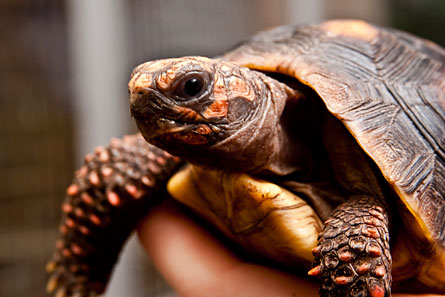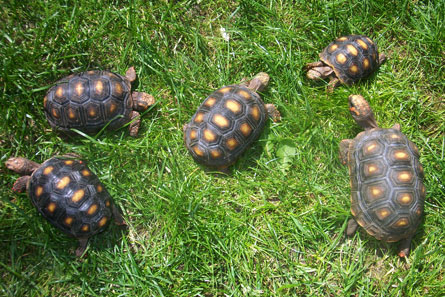View a video of tortoises exhibiting social learning from their peers.


Animal hermits can learn from their peers, researchers say, even though they rarely encounter one another in the wild.
Red-footed tortoises in the wild live a typically lonely tortoise life, without even being cared for by their parents. But in the lab, they can pick up hints to solving a problem by watching a more accomplished tortoise, says cognitive biologist Anna Wilkinson of the University of Vienna. “It’s the first demonstration of social learning in reptiles,” she says.
It’s also the first demonstration that nonsocial animals can watch a neighbor and then complete a task that they couldn’t figure out readily on their own, she says. The tortoises’ feats are “challenging the idea that social learning is an adaptation for social living,” Wilkinson and her colleagues say in a paper going online the week of March 30 in Biology Letters.
In mammals, birds and insects, the power to learn from watching a neighbor has shown up in animals that live in groups, like chimps and honeybees. So scientists routinely link social learning to social living, Wilkinson says. However, she proposes that watching a neighbor may be just another way that any good learner, social or not, picks up on clues for success.
“It might be the case that social learning in social and non-social species is different in interesting ways, and that would be great to know,” says animal behaviorist Bennett G. Galef of McMaster University in Hamilton, Canada, who was not involved in the study.
The idea for the new study came from watching a red-footed tortoise in captivity apparently going to the same spot where another one had been eating, says Wilkinson, who repeats a lament that the animals’ slowness gives them “an undeserved reputation for stupidity.”
Not many nonsocial animals get tested for social learning, Wilkinson says. A 1992 paper (which stirred up debate about methods) reported that octopuses can boost their scores on a lab test after watching a trained octopus.
Testing for the ability to learn from others required finding the right task since “tortoises aren’t brilliant at manipulating,” she notes. So instead of fishing food out of crevices or moving levers, she and her colleagues required the animals to detour around a wire mesh fence to reach a bowl of strawberries or other prime treats.
Four tortoises failed to figure out how to do this when she gave them a two-minute chance once a day for 12 days. Wilkinson then trained a tortoise named Wilhelmina to walk around the fence. After weeks of education, she reliably managed the detour.
When four other turtles, including Wilkinson’s pet Moses, were allowed to watch Wilhelmina’s journey, they proved much more likely to reach the bowl themselves.
Two tortoises caught on the first time they watched Wilhelmina, and two, including Moses, managed on at least 11 out of 12 days.
These animals weren’t just following some kind of scent trail, Wilkinson says. She shifted around the wood chips covering the testing site before allowing an inexperienced turtle to have a go at the problem. Also, she notes, some of the turtles reached the reward by detouring left, although Wilhelmina had detoured right.
Finding such talent in a tortoise doesn’t really surprise reptile ethologist Gordon M. Burghardt of the University of Tennessee in Knoxville. He and former student Karen Davis are now writing up their own experiment showing social learning in a turtle.
Other scientists who study social learning say they want to know more about the tortoises’ powers before declaring what this might mean for social learning. “Would the observing animal be able to learn the detour task as easily if the demonstration had involved an object [such as a colored ball] moving around the barrier?” asks Thomas Zentall of the University of Kentucky in Lexington.
In a sped-up video of tortoise tests in a lab, animals with no coaching fail to get a treat on the other side of wire fence. When researchers let the trained tortoise Wilhelmina demonstrate, an observer tortoise manages readily.
Credit: Anna Wilkinson






